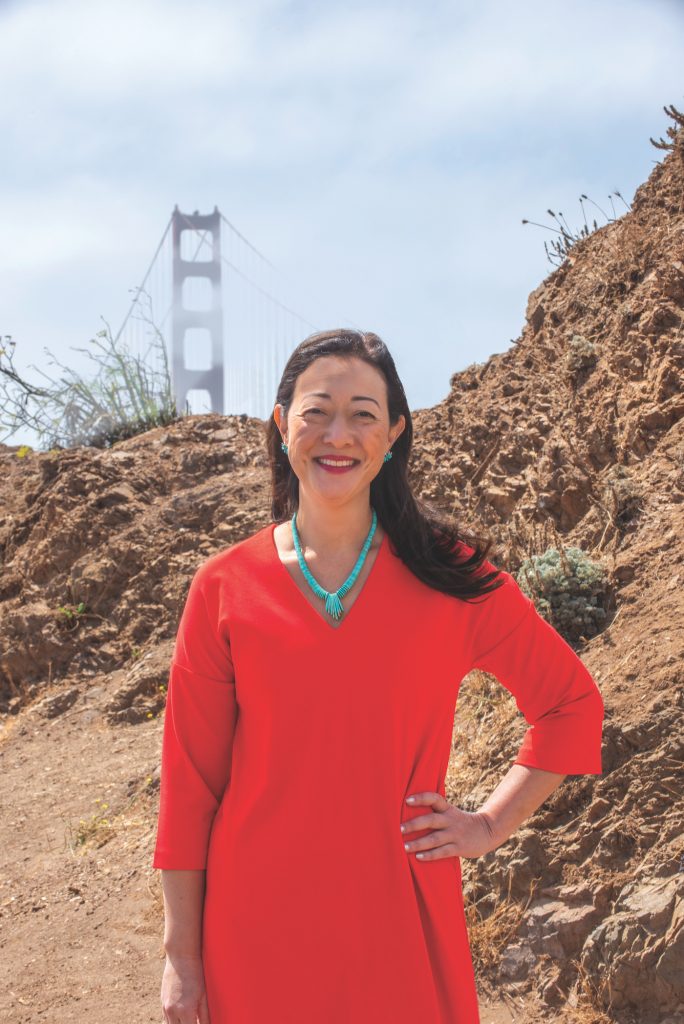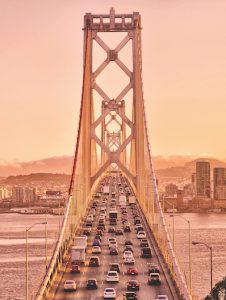Bringing Environmental Justice Home

Rhea Suh spent years working for both the Hewlett and the Packard foundations here in the Bay Area before setting off on a career path that would see her in the Obama administration and leading one of the most influential environmental activism organizations in the country, the Natural Resources Defense Council.
“My journey unexpectedly took me back to the East and I stayed for longer than I thought,” says Suh, who became president and CEO of the Marin Community Foundation in late 2021. The return to the Bay Area, where her parents and three siblings live, “truly feels like coming home.”
Suh brings with her a rare mix of philanthropic, nonprofit, and government experience, positioning her to use the lessons learned here to have a global impact.
“There isn’t anything that I can imagine wanting to do more right now,” she says. “In these fluid times where so much is unsettled, the more that we can focus on uplifting the creative energy that exists in communities, the better off we’ll all be.”
The following conversation has been edited for concision.
“The reality is that we have the best environmental laws and regulations of any country in the world, and yet there are concentrated pockets of pollution that oftentimes are located in poor communities of color. That is simply shameful. Now that we are in this new inflection point in our country’s history where we’re looking very deeply into issues of social justice and social inequity, we have a profound opportunity to rethink what environmentalism means and how we can ensure that the practice of conservation and environmental protection be truly carried out to ensure that everyone can enjoy a healthy environment.”
You served as an assistant secretary at the Department of Interior for the Obama administration, which I imagine gave you intimate knowledge of how federal money flows. As we recover from the pandemic, how can community foundations engage with government?
While there’s a history of that kind of collaboration, I think that there’s also a missed opportunity. And I’m hoping, given the circumstances that we find ourselves in, that there will be an opening for community foundations to really step up to the plate and provide the kind of on-the-ground expertise and assistance that the federal government needs.
The federal government just doesn’t have the bandwidth to actually go down to a community level and figure out what needs exist. Obviously, a lot of the money that’s flowed through the economic assistance associated with the pandemic has gone through state and then local channels.
But to the extent to which you can get other nongovernmental participants to be part of that conversation, I think you just couldn’t ask for better experts than local community foundations, which you can find in every corner of the country.
How do you see the Marin Community Foundation and others working with government on a major issue like climate change?
There’s a lot of pressure and intensity on taking concrete actions because the level of climate chaos that we’re already experiencing is so significant that something has to be done. A lot of what’s been challenging around climate policy is that it’s been very top down.
You can create loan programs or new federal funding, but those programs aren’t necessarily based on what’s actually happening in a community. And so, the question is: How do you elevate a practically proven set of programs, versus guessing if a federal program is somehow going to make a difference? We need to be thinking through what’s happening at the local level, which is where a lot of the innovation and solutions also end up happening. And then connect that bottom-up approach with the top down.
I think that there’s an incredible opportunity with climate to really think about the issue in a much more disaggregated way than we’ve seen so far.
One of the stops on your interesting career path was as president of the National Resources Defense Council. What drew you to environmentalism in the first place?
I have a fairly pedestrian reason for getting excited about the environment, which is I grew up in Boulder, Colorado. It’s one of the most beautiful places in the world. And I spent my childhood camping, hiking, fishing, and in many ways, I think, taking for granted this incredible abundance of nature.
And then when I went to college, I made the ironic choice of wanting to study environmental science in New York City. I got a pretty significant education on the reality of environment, which is that the environment isn’t just the green stuff, it’s the brown stuff as well.
Yet at the same time, I think the definition of nature within the context of how we’ve traditionally viewed it has been too limiting because it is really the environment that we all live in and interact with. This is different depending on where you live, what you look like, how much money you make. Where you’re from and the reality of the significant inequities that have existed in the environmental space have always been very clear to me.
And so, while Northern California, California generally, is a stronghold of people who largely really care about the environment, I think it is just emerging as a stronghold for people who really care about the environment and people, and in particular people who have long been disadvantaged and overburdened by the consequences of environmental pollution. So you’re seeing this huge uprising of environmental justice organizations in the state that are incredibly diverse and powerful, and really wielding that power in very significant ways. This, I believe, is the bellwether of how the nation should be thinking about environmental issues.
You evoked the concept of environmental justice. Why is that so important to you?
The history of the environmental movement has too often separated the environment from people and led to many instances where environmental goals only benefited a select group of people. Indeed, the reality is that we have the best environmental laws and regulations of any country in the world, and yet there are concentrated pockets of pollution that oftentimes are located in poor communities of color. That is simply shameful. Now that we are in this new inflection point in our country’s history where we’re looking very deeply into issues of social justice and social inequity, we have a profound opportunity to rethink what environmentalism means and how we can ensure that the practice of conservation and environmental protection be truly carried out to ensure that everyone can enjoy a healthy environment.
Given the size of the issues that this region and this nation are facing, how can philanthropy make a dent?
I’ve had the privilege of working at some of the largest foundations in the country.
And even at those large foundations, we were constantly trying to find leverage points. Most often it was leverage points with other foundations, but in some cases it was leverage points with government. So we really need to figure out ways to find those common interests and where they align. There are many of them, and it’s super fun because not only do you get all sorts of interesting new partners, you really do get outsize impact.
In particular, for community foundations, it’s also using convening as a leveraging force. Creating forums and opportunities for grantees to get together, to be able to think differently, for them to collaborate with one another, is a huge instrument that the foundations have.
